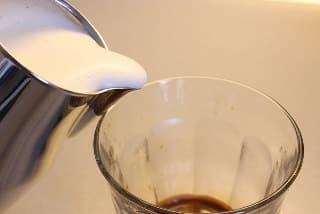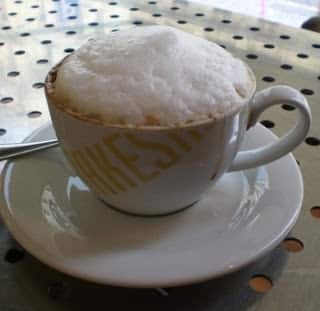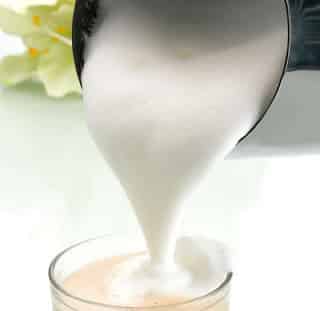 So what’s the difference between making milk froth and milk foam anyway? Is there a difference at all?
So what’s the difference between making milk froth and milk foam anyway? Is there a difference at all?
These were the very first simple questions I had about frothing milk when I started experimenting with making lattes and cappuccinos for the first time in my own home and they’re probably the first questions most beginners have too.
First of the difference between froth and foam is simple and mostly semantics. They are both basically the same thing. Milk with small bubbles.
The difference is in the texture.
Foam usually consists of bigger, lighter bubbles that tend to sit on top of the milk or coffee. Froth is consistent with tighter bubbles that mix together with the milk and coffee resulting in a thicker textured drink from top to bottom.
Foam is much easier to make and many working baristas really only make foam with their manual steam wands despite their best intentions.
When tighter froth is not made correctly steamed milk added to drinks tends to be flat even though there may be tons of fluffy foam on top of the drink. A keen eye can see the difference and most people can taste the difference too.
In short its all about the texture here. Flavor only slightly factors in.
In fact most stand-alone milk frothers like the Aeroccino3, the HadinEEon Milk Frother, or the very inexpensive frother wands like this one still don’t really make quality milk froth although they do make good fluffy foam that most people are perfectly happy with.
So how are these froth bubbles made?
They’re made in both professional settings and in some homes. They are typically made with a steam wand which can be purchased as a stand alone device or can be found as a standard feature on virtually all espresso makers made for both commercial and home use.
For those of us that don’t have espresso machines and don’t want to buy extra accessories you can make some forms of frothed/foamed milk at home by using your french press pot and your countertop microwave.
Another difference between frothed milk and foamed milk is that frothed milk tends to be harder to make and is usually not made by inexperienced home baristas. Foam is typically easier to make with a press pot and it’s also easier to make with an automatic steam wand too. To make excellent froth takes a lot of practice and a bit of talent and usually better equipment
For basic drinks that will turn the heads of most people a basic foam will be good enough to produce a wow so don’t worry to much about getting perfect froth unless you are trying to impress pros. Most people who buy these drinks all the time won’t notice the difference anyway, especially if they get these drinks from Starbucks with a lid. You can’t even see the foam or froth anyway.
If you really want to learn to make your own froth, which is really the best way to get a high quality froth with super tight bubbles is to practice with a steam wand or atleast use one of the higher end frother machines.
This dedicated steam wand is available on Amazon for a jaw dropping price but this top-of-the-line frother by Breville is actually affordable and it receives extremely good reviews while making a great froth. It is one of the best values IMO giving you the best quality froth for the price.
As you can see in this picture the foam is really light and airy. The bubbles are bigger and this stuff will float on the top of just about anything.

In contrast the picture below shows tight frothy bubbles. These bubbles are heavier and will mix into a beverage much better.

If you are looking to make a Latte then you are going to want to make a bit of foam and use the frothier milk underneath the foam for the majority of the milk added. Just top the cup with a bit of fluffier foam and you’ll have a great cup.
A Cappuccino would be opposite. Make your foamed milk and only add a little frothy milk on the bottom first and that cap it with a load of fluffy foam on top of your cup.
If you want to get a better distinction between foam and froth then keep practicing and put a wand milk steamer on your wishlist.
Let’s Look at the Differences a Little More
Coffee and Milk 101
Lattes, cappuccinos and macchiatos are probably the most favorite espresso drinks with steamed milk of them all.
Baristas love making these and they have injected art and creativity to make this delightful drink more appealing to people. But what is the real impact of adding milk to your coffee?
Milk proteins and milk fat play an important role in creating milk froth and milk foam. These are essential ingredients in making your favorite latte and cappuccino.
- Milk fat – Milk fat serves as protective membrane to lock in the flavor of milk.
- Milk protein – Whey and casein proteins are the top two proteins found in milk. These proteins, when mixed with coffee, create that distinct creamy taste that we love with our latte and cappuccino. And when your coffee is hot, it makes the milk taste creamier.
- Homogenized milk – Milk fat is reduced through a process called homogenization. It helps to store milk for longer periods of time without the milk creaming problem that often happens when milk is stored.
We mentioned about milk froth and milk foam. Are they one and the same? Or do they have differences? Let’s find out.
Milk froth vs milk foam?
Coffee experts agree that milk froth and milk foam are essentially the same. Both are milk with bubbles. However, the difference lies in the texture.
Milk froth – has tighter bubbles that mixed together with milk and coffee to create a thicker and textured drink. Milk froth is often used for lattes.
Milk foam – has bigger and lighter bubbles. It often settles on top of the coffee to create that fluffy, foamy topping. Milk foam is perfect for cappuccino.
Milk foam is easier to create. Milk froth requires a certain hand skill to make a tighter froth perfect for gourmet latte drinks and latte art.
How do you make milk bubbles?
Frothing or foaming milk is basically introducing air to the liquid. This create bubbles. One important element to make this a success is to ensure that your milk is warm enough. Not cold or too hot. Just warm. The recommended temperature is about 95 degrees Fahrenheit.
There are various ways to make milk bubbles:
- Shaking in a jar. Put warm milk in a jar. Close the lid tightly and shake vigorously. This creates large bubbles of milk. Good enough for a homemade cappuccino.
- Whisk by hand. Place warm milk in bowl. Whisk the milk back and forth. This is creates a more even foam compared to the jar exercise.
- Use an electric mixer. Heat the milk. Place in the mixer dish. Whisk for a minute until you get the desired fluffiness.
- Frothing wand. Warm your milk. Put the wand in the container where you are warming the milk. Whisk the want until you get the desired froth.
- Put warm milk in a blender and set to medium speed. Always keep lid close.
- French press. Yes, you can use it. Place warm milk in the carafe. Press the plunger up and down until you get the desired froth.
Which milk is best for coffee?
There is no one answer to this question. However, coffee experts suggest that some milk works well for coffee while others are not.
For latte and cappuccino – Milk with a higher fat is better. Experts say that milk with 12% fat works really well for drinks with milk. Skim milk is a no-no. It makes a watered down latte.
Barista milk – Known as Straus Barista Milk, this is specifically crafted for barista style coffee. It’s a cream-top milk that is lightly homogenized. It is more stable and good for frothing and foaming.
Black coffee – It’s perfect just the way it is. Just add sugar if you like it sweet. Adding milk will only reduce the subtle flavor and fruity notes of coffee.
Diner coffee – Best used with powder creamer to mix well with the coffee.
Recommended milk frothers in the market
If you have the budget, you can take a look at these milk frothers:
Breville Milk Café
This nice milk frother can make 3 cups of frothed milk. It has an auto off feature. It turns off when the desired temperature and froth is achieved. It also comes with different discs – cappuccino and latte. This helps creating the perfect froth for your favorite drink. It works well with organic milk.
Epica Automatic Milk Frother
This milk frother can use hot or cold milk, perfect for hot latte or iced cappuccino. It can heat a cup of milk and use it for 3 or more cups of latte. Milk volume increases when ferothed. The carafe is easily detached for quick cleaning.
Nespresso Aeroccino Plus Milk Frother
It can hold up to 250 ml of milk. It can make hot and cold milk froth for lattes and cappuccinos. It can make milk froth in as quick as 70 seconds.
HIC Milk Creamer Frother
It has 14 oz capacity and frothes milk in just a minute. It’s a manual frother with a plunger that you push up and down.
